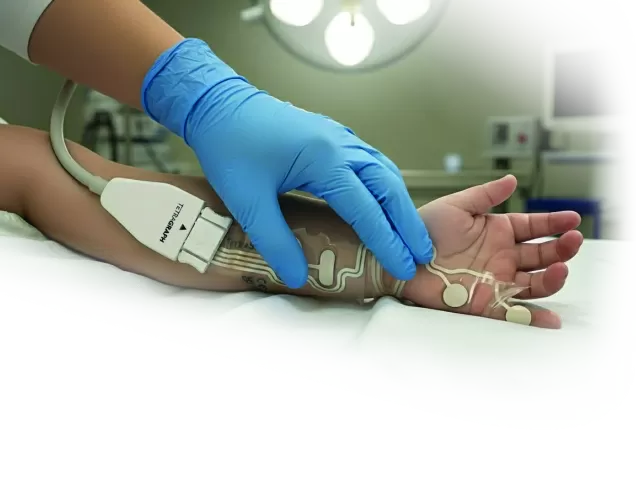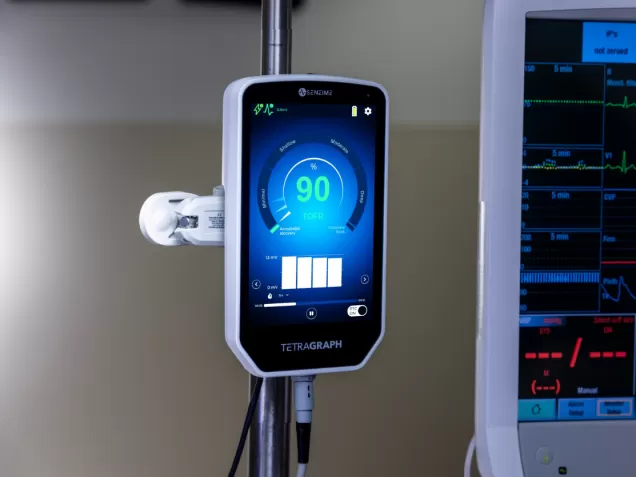Studies show that 16–40% of pediatric patients experience residual paralysis when anesthesia is managed without objective monitoring (Faulk et al., 2024; Domenech et al, 2019; and Kotake, 2013).
Objective electromyography (EMG) monitoring significantly reduces residual block vs. clinical signs or accerelomyography(AMG).
Expert discussion with ESPA/ESAIC guideline author
Raising the Standard: New Pediatric Guidelines for Neuromuscular Block Management
Watch recording
EMG-based quantitative TOF monitoring enables safe and accurate neuromuscular block management for your most delicate patients.
Supporting you in your choice of neuromuscular blocking agents (NMBA).
Guiding you in choice of reversal agent type and reversal dose for your specific case.
Helping you to choose if spontaneous recovery is an option or not, and if adequate recovery of breathing muscles is obtained.
Assisting you in finding the correct timing for safe tracheal extubation.

TetraGraph and TetraSens Pediatric provide safety you can trust, ensuring full recovery before extubation to protect your most vulnerable patients.
- Easy and intuitive sensor application
- Gentle on delicate skin
- One-size flexible design to fit different patient sizes
- Trusted EMG technology

TetraGraph and TetraSens Pediatric
- Pediatric-specific and skin-safe design: Regulatory-cleared separately and specifically for infants ≥1 month*, with a low-profile, flexible electrode array gentle on delicate skin.
- Proven signal strength feedback: EMG technology delivers strong, consistent signals—even in children <2 years or with tucked arms where AMG fails. Individualized signal strength confirms correct sensor placement at the start and ensures accurate readings throughout the case.
- Seamless workflow: Quick and easy setup, no calibration required, and continuous TOF data without interrupting clinical flow.
- Smarter dosing decisions: Intuitive TetraGraph Level-of-Block Gauge provides real-time feedback to guide precise NMBA and reversal dosing, optimizing safety and minimizing unnecessary drug use.
Get started today!
Contact us to request a complimentary demo, and explore how TetraGraph and TetraSens Pediatric can help you enhance pediatric patient care.
TetraSens Pediatric can easily be placed on either hand or foot, helping to improve the workflow in your OR setting. It’s cleared to be used on pediatric patients from 28 days after born.
- Faulk, Debra J., et al. “The Incidence of Residual Neuromuscular Block in Pediatrics: A Prospective, Pragmatic, Multi-institutional Cohort Study.” Cureus, vol. 16, no. 3, 2024, e56408.
- Motamed, C. “Intraoperative Monitoring of Neuromuscular Blockade.” Life, vol. 13, no. 5, 2023, p. 1184.
- Carvalho, H., et al. “Forty Years of Neuromuscular Monitoring and Postoperative Residual -Curarisation: A Meta-analysis.” British Journal of Anaesthesia, vol. 125, no. 4, 2020, pp. 466–482.
- Owusu-Bediako, Kwaku, et al. “Feasibility of Intraoperative Quantitative Neuromuscular Blockade Monitoring in Children Using Electromyography.” Saudi Journal of Anaesthesia, vol. 16, no. 4, 2022, pp. 412–418.
*Age is defined based on the Food and Drug Administration’s FDA’s guidance: “…the upper age boundary for neonates (through the first 28 days of life) and the lower age boundary for infants (29 days) are defined in days rather than months, consistent with national statistical standards for reporting neonatal and infant mortality according to post-natal age.”
